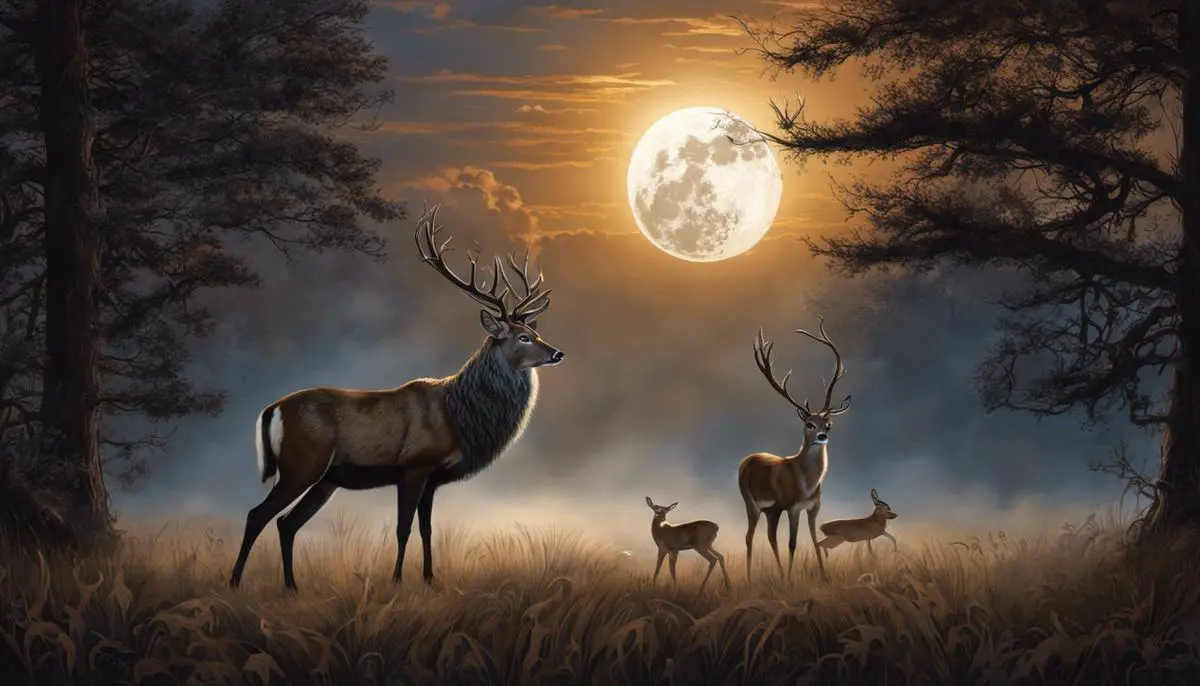Delving into the rich tapestry of lunar folklore, the Buck Moon stands out as a culmination of numerous cultures, beliefs, and scientific facts. This celestial spectacle, appearing in July, holds a special place in the calendar year, especially among the indigenous tribes of American origin. The Buck Moon marks an intriguing intersection where mythology, traditions, and science meet; it’s a timeless emblematic representation of when the young male deers begin to grow their antlers – a remarkable phenomena narrated through legends, myths and folklore reaching back to the Aboriginal American communities. From cultural significance attached to this annual event by diverse cultures around the world, to the wealth of stories and myths that revolve around it, and the science explaining its occurrence – understanding the allure of the Buck Moon could provide a fascinating lens into the unique ways humans interpret and interact with the natural world.
Buck Moon and its Origin
Origin of the Buck Moon
The full moon that graces the sky in July is popularly known as the Buck Moon. This term can be traced back to the Native American tribes residing in what is now the northeastern and central United States, namely the Algonquin tribes. The name was influenced heavily by the natural cycles of the deer that these tribes would observe. Early summer is the season when the antlers of a buck – a male deer – begin to sprout from their foreheads, covered in a velvety fur. Hence, they called the full moon of July, when this phenomenon occurs, the Buck Moon.
Significance of the Buck Moon in Native American Culture
Native American tribes had a habit of observing the natural world and incorporating these elements into their calendar. To them, nature’s patterns were a useful way of marking time and tracking the changing seasons. The tribes did not follow the Roman calendar with its months named after gods and emperors. Instead, their calendar was independent and based on lunar cycles. Each full moon was associated with the significant natural phenomena happening during that time of the year. This was how they kept track of time and remembered important events.
Myths and Stories
Stories and myths around the full moon Buck Moon differ depending on the tribes and their unique traditions and beliefs. Some tribes believed that the Buck Moon was a sign of plentiful game and thus a prosperous hunting season. Others would craft tales around the Buck Moon, tying it to narratives of courage and strength, inspired by the majestic sight of a buck with newly grown antlers.
Interpretations of the Buck Moon
The Buck Moon, like other lunar phenomena, has been the subject of various interpretations. Astrologers interpret the Buck Moon as a time to shed burdens and let go of things that no longer serve us, just as bucks shed their antlers. Meanwhile, spiritualists could see it as a moment of growth and maturation, reflecting the journey of young bucks towards adulthood.
The Significance of Buck Moon in Today’s Society
Today, the Buck Moon holds significant meaning and is celebrated across various cultures and communities. Especially among modern pagans and Wicca practitioners, this full moon is revered as the Blessing Moon, symbolizing the preparation phase for the impending harvest season. The Buck Moon serves as a beautiful representation of the harmonious connection between nature’s cycles and the lunar calendar. As a global occurrence, the appearance of the full moon in July brings joy and fascination to many, reminding us of its origin in Native American traditions, where it was seen as a marker of nature’s relentless rhythm.
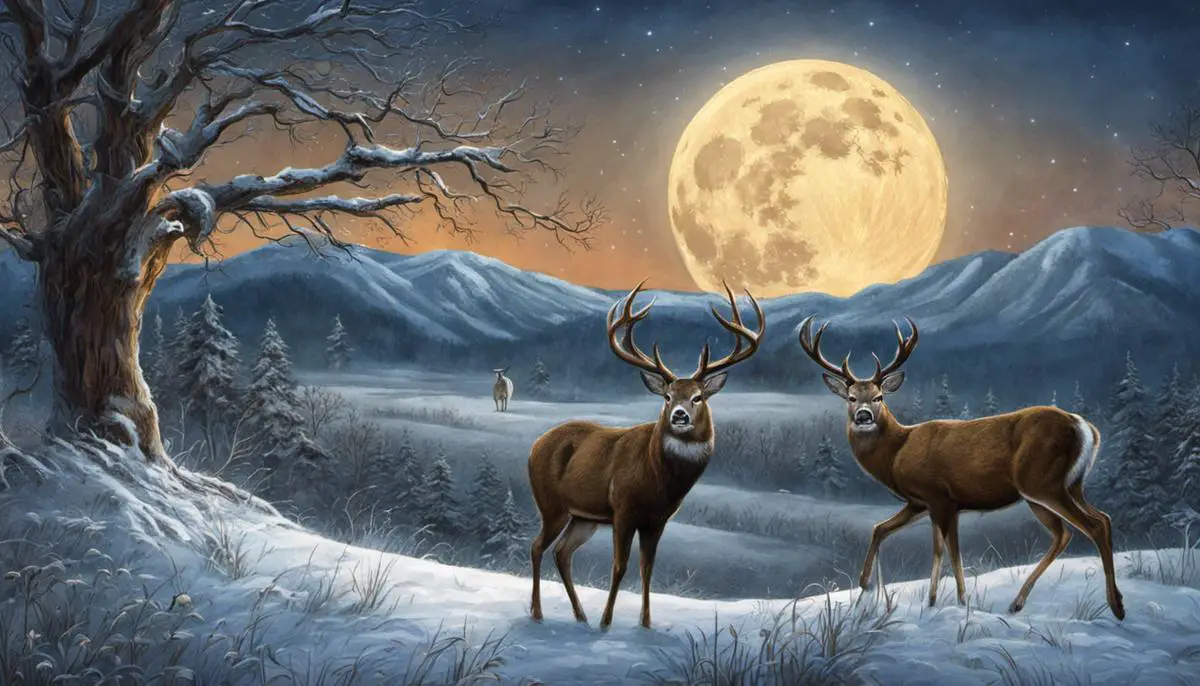
Symbolism and Cultural Significance of Buck Moon
Deciphering the Buck Moon
The concept of “Buck Moon” originates from the Algonquin tribes of Native America, who named July’s full moon thus as it is during this month that the new antlers of young bucks begin to sprout. This cyclical shedding and regrowth of antlers mirrored the idea of renewal and fresh starts, which this moon came to symbolize. The Buck Moon held particular importance in the hunting schedule of indigenous North American communities, acting as the indicator of the deer reaching their full vitality.
Symbolism of Buck Moon in Different Cultures
Various cultures have their unique interpretations and myths surrounding the Buck Moon. These interpretations often contain teachings about nature, life, and the changing seasons.
In some Native American cultures, for example, the Buck Moon serves as a reminder of perpetual change and renewal. The regrowth process of buck’s antlers was seen as a symbol of rebirth, which correlated with the abundance brought by the summer harvest.
Among Celtic traditions, July’s full moon is commonly known as the Blessing Moon. This timing coincides with the festival of Lughnasadh, which celebrates the beginning of the harvesting season. Associated with abundance and gratitude, this moon is believed to carry potent energy for reaping the spiritual and physical bounties.
Stories and Myths about Buck Moon
One notable myth comes from the Anishinaabe tribe in North America. They believe that when July’s full moon shines brightest, it indicates that a spirit known as Nanabozho is taking the form of a giant deer. With antlers reaching into the heavens, Nanabozho moves through the forest bringing wisdom and knowledge to his people.
In some Celtic and European folklore, it was often believed that the full moons of summer, including the Buck Moon, were enchanted times when fairies and other supernatural beings would appear. Dancing in circles known as fairy rings, these creatures were said to be visible under the bright light of the full Boon Moon.
In Japanese folklore, the concept of “Tsuki no Usagi” or “Moon Rabbit” is widely recognized. Though not directly related to the Buck Moon, it illustriously imagines a rabbit pounding mochi in the moon, adding a vibrant mythological layer to the perception of full moons in this culture.
Buck Moon: Its Modern Significance
The Buck Moon historically holds an important place in many cultures, and in contemporary times, its significance has not diminished but shifted to celebrate its natural splendor and link to the animal kingdom. Activities including moon gazing, night-time photography, and walks under the moonlight are contemporary practices that keep the Buck Moon relevant today, serving as a poignant reminder of our everlasting bond with nature and the universe beyond.
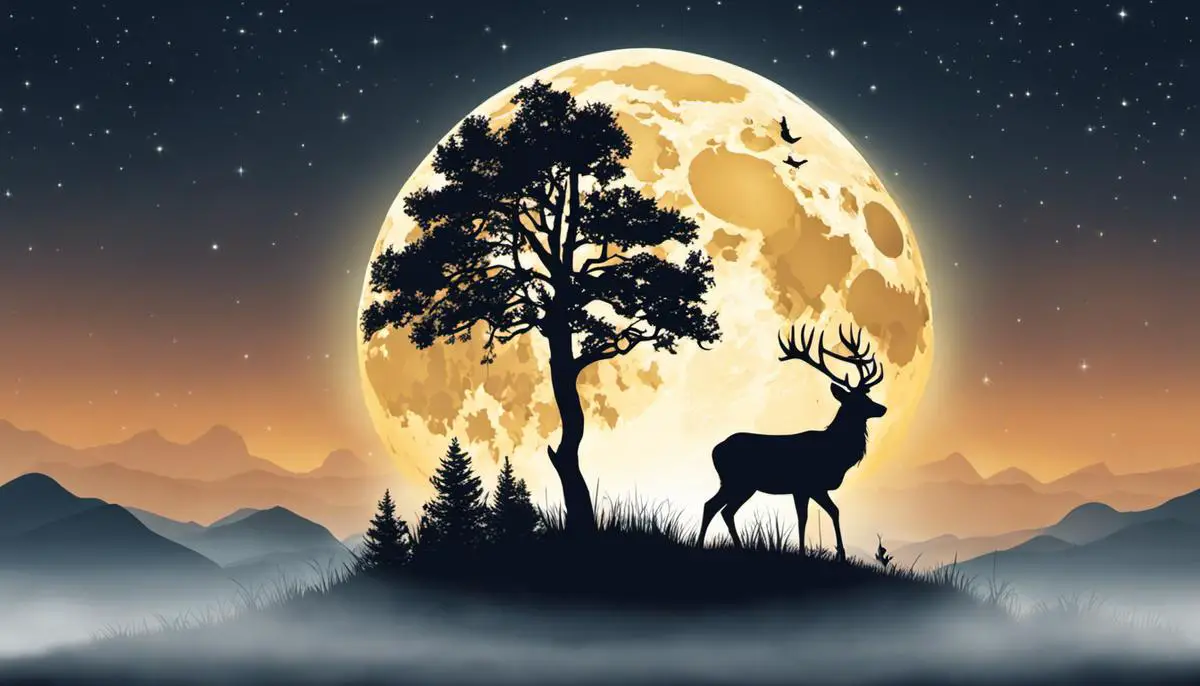
Myths and Stories Associated with Buck Moon
Digging into the Origins: Buck Moon
Native American folklore, particularly from the Algonquin tribes, originated the term “Buck Moon” to refer to the full moon that adorns the July night sky. This special title was bestowed in recognition of the period when bucks start growing new antlers. Over the years, this natural occurrence has been the cornerstone of various myths and folklore, adding layers of intrigue and cultural depth to this astronomical event.
Buck Moon and Lunar Beliefs
Many societies around the world held ancient beliefs about the full moon’s influence on humans and the environment. The Buck Moon, seen as a sign of maturation and coming of age, has been featured in folklore as a period of increased tension or misfortune. For instance, it was thought that during a Buck Moon, fights among bucks would be more frequent due to their new antlers, leading to a general belief in heightened conflict.
Buck Moon and Crop Growth
Agricultural communities would also often associate the Buck Moon with crop growth. The Buck moon was seen as a sign to start harvesting crops in preparation for the upcoming winter. This annual phenomena hence gathered a mystical status, with stories being circulated about it being a symbol of abundance and harvest.
Spiritual Significance
In various cultures, the full moon holds great spiritual significance. The Buck Moon is no exception to this, with numerous myths surrounding its symbolic importance. In certain indigenous cultures, it was seen as a symbol of virility and power due to its association with the male deer or “buck”.
The Effect on Animals
Apart from the effect on deer, many myths linger about the Buck Moon’s influence on other animals. As per some traditional beliefs, wolves are more vocal during the Buck Moon. Similarly, more hoots from owls were associated with this specific full moon phase. These tales, while devoid of significant scientific evidence, add an element of magic and mystery to the phenomenon.
Buck Moon in Popular Culture
The Buck Moon has found its place in popular culture as well. Various literary and cinematic works have incorporated the folklore surrounding the Buck Moon. For example, in fantasy novels, the magic or energy of characters often fluctuates during a Buck Moon, reflecting the mythical associations of strength, fertility, and change.
An Overview
The full moon known as Buck Moon is shrouded in myths and captivating tales from diverse cultures, drawing attention to the awe it inspires among observers. Although differences exist in the themes and origins of these stories, they collectively showcase the awe-inducing spectacle and cultural significance of full moons like the Buck Moon.
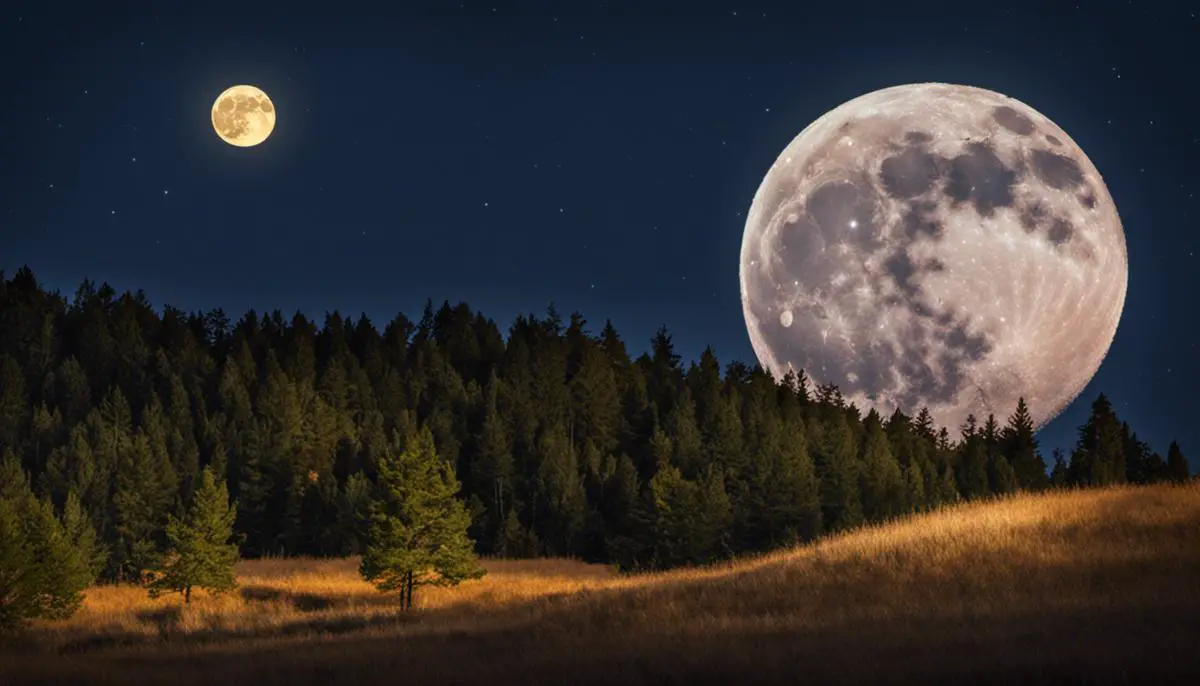
Scientific Explanation and Astronomical Significance of Buck Moon
The Science and Astronomical Significance Behind Buck Moon
Often referred to as the Thunder Moon, Hay Moon, or Wort Moon, the full moon of July is commonly known as Buck Moon. This name was coined by Native American tribes, linking the appearance of July’s full moon with the time when male deer, or “bucks”, start growing their new antlers. These tribes would often name full moons based on prevalent activities or natural phenomena occurring during that month, leading to “Buck Moon” coming into existence.
On the scientific front, despite lacking any particular astronomical significance, the occurrence of Buck Moon plays a role in marking the lunar cycle’s progress. The moon circles Earth in about 27.3 days, displaying different phases – full, new, or somewhere in between. Every month’s full moon has a unique name, and in July, it’s the Buck Moon. Signifying one of the earliest full moons of summer, Buck Moon takes place when Earth is positioned between the Sun and the Moon, providing a view of a fully-lit moon in our sky.
Debunking Myths About Lunar Influence
The full moon, including the Buck Moon, often comes with a host of myths and stories about its potential influence. Some prevalent myths suggest that full moons can impact human behavior resulting in increased hospital admissions or crime rates. Additionally, there are sometimes claims of the Lunar cycle affecting birth rates or feature in various hunting and agricultural folklore.
Scientific studies, however, consistently debunk these myths. Findings from numerous studies suggest no substantial evidence indicating the Lunar cycle has an effect on human behavior, crime rates, or birth rates. This means the full moon, regardless of whether it’s the Buck Moon or otherwise, doesn’t have these supposed impacts.
Myths and Stories about Buck Moon
There are several myths and stories about the Buck Moon. Many Native American tribes looked at the moon as an essential guide to understanding their world. For them, it would have been necessary to track when the buck deer would lose their antlers and begin regrowth — a time signaled by the Buck Moon.
In European folklore, the Buck Moon was sometimes referred to as the Hay Moon due to the July hay harvest. Other times, it was named the Thunder Moon because of the frequent thunderstorms during this mid-summer period.
Perhaps one of the most captivating stories around the Buck Moon revolves around the Thunderbird, a mythological creature prevalent in certain Native American cultures. The Thunderbird was often associated with summer thunderstorms, and its presence was tied to the occurrence of the Buck Moon. The creature, usually depicted with an impressive wingspan, was believed to create thunder by flapping its wings, and sparks from its eyes were thought to cause lightning. But, like all lunar mythology, it is a story steeped in rich cultural context, rather than astronomical or scientific fact.
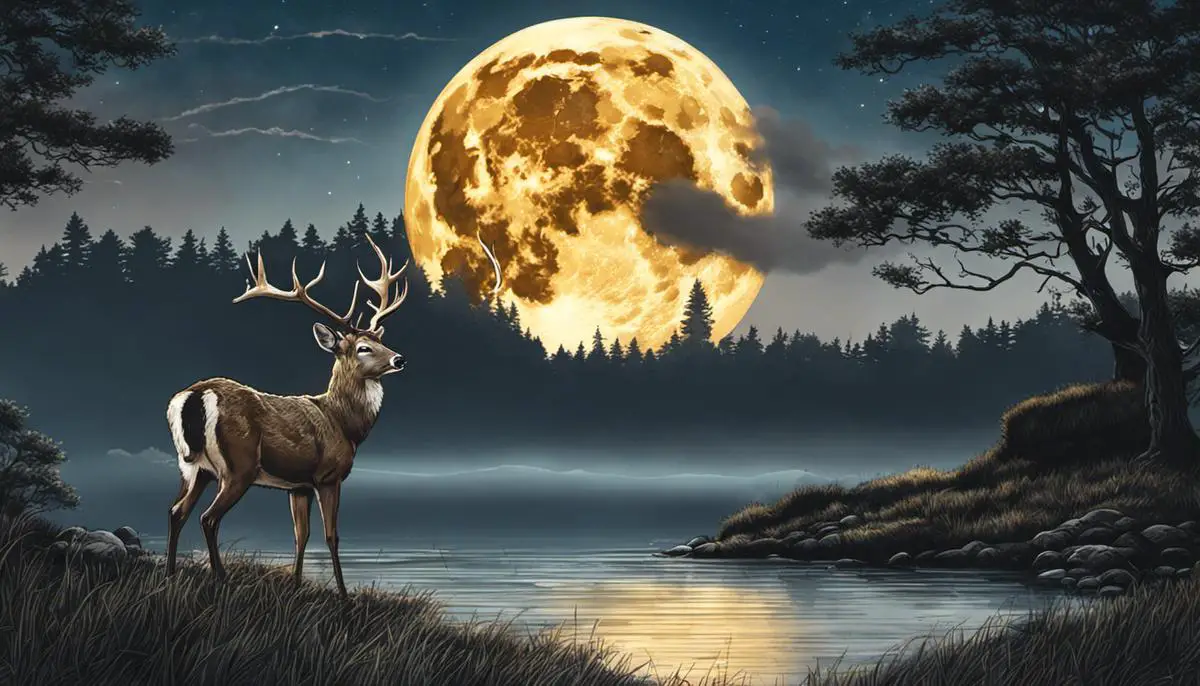
The lore of the Buck Moon, its cultural symbolism, and the scientific reasoning behind its occurrence enriches our understanding of how historical events and natural phenomena can merge into compelling narratives that span generations. Folktales help shape our understanding of the physical world while connecting us to our ancestors’ perception of the universe and their day-to-day lives. Science serves to unravel the mysteries and dispel fallacies, enhancing our comprehension of the cosmos. This intersection of cultural narratives and scientific knowledge propels our ongoing voyage to decipher the secrets of the universe, driving our curiosity forward. Furthermore, the Buck Moon remains a lasting symbol that showcases the fascinating interplay between nature, culture, and scientific exploration—the pulsating heartbeat of human curiosity throughout the ages.
![]()
